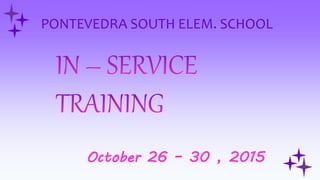
Multiple Intelligence
- 1. PONTEVEDRA SOUTH ELEM. SCHOOL October 26 – 30 , 2015
- 4. What are the types of learning styles?
- 5. Visual learners Learning through seeing……. These learners need to see the teacher’s body language and facial expression to fully understand the content of a lesson. They tend to prefer sitting at the front of the classroom to avoid visual obstructions (e.g. people’s heads). They may think in pictures and learn best from visual displays including: diagrams, illustrated text books, overhead transparencies, videos, flipcharts and hand – outs. During a lecture or classroom discussion, visual learners often prefer to take detailed note to absorb the information.
- 6. Auditory learners Learning through listening……. They learn best through verbal lectures, discussions, talking things through and listening to what others have to say. Auditory learners interpret the underlying meanings of speech through listening to tone of voice, pitch, speed and other nuances. Written information may have little meaning until it is heard. These learners often benefit from reading text aloud and using a tape recorder.
- 7. Tactile/Kinesthetic learners Learning through moving, doing and touching……. Tactile/Kinesthetic persons learn best through a hands – on approach, actively the physical world around them. They may find it hard to sit still for long periods and may become distracted by their need for activity and exploration.
- 8. What is multiple intelligence? Conceived by howard gardner, multiple intelligences are seven different ways to demonstrate intellectual ability
- 9. What are the types of multiple intelligence?
- 10. Visual/Spatial intelligence Ability to perceive the visual. These learners tend to think in pictures and need to create vivid mental images to retain information. They enjoy looking at maps, pictures, videos and movies Their skills includes: puzzle building, reading, writing, understanding charts and graphs, a good sense of direction, sketching, painting, creating visual metaphors and analogies (perhaps through the visual arts), manipulating images, constructing, fixing designing practical objects, interpreting visual images. Possible career interests: navigators, sculptors, visual artists, inventors, architects, interior designers, mechanics, engineers
- 11. Verbal/Linguistic intelligence Ability to use words and language. These learners have highly developed auditory skills and are generally elegant speakers. They think in words rather then pictures. Their skills include: listening, speaking, writing, story telling, explaining, teaching, using humor, understanding the syntax and meaning of words, remembering information, convincing someone of their point of view, analyzing language usage. Possible career interests: poet, journalist, writer, teacher, lawyer, politician, translator
- 12. Logical/Mathematical intelligence Ability to use reason, logic and numbers. These learners think conceptually in logical and numerical patterns making connections between pieces of information. Always curios about the world around them, these learner ask lot of questions and like to do experiments. Their skills include: problem solving, classifying and categorizing information, working with abstract concepts to figure out the relationship of each to the other, handling long chains of reason to make local progressions, doing controlled experiments, questioning and wondering about natural events, performing complex mathematical calculations, working with geometric shapes. Possible career paths: scientists, engineers, computer programmers, researchers, accountants, mathematicians
- 13. Bodily/Kinesthetic intelligence Ability to control body movements and handle objects skillfully. These learners express themselves through movement they have a good sense of balance and eye – hand co – ordination (e.g. ball play, balancing beams). Trough interacting with the space around them, they are able to remember and process information. Their skills include: dancing, physical co – ordination, sports, hand on experimentation, using body language, crafts, acting, miming using their hands to create or build, expressing emotions through the body. Possible career paths: athletes, physical education teachers, dancers, actors, firefighters, artisans
- 14. Musical/Rhythmic intelligence Ability to produce and appreciate music. These musically inclined learners think in sounds, rhythms and patterns. They immediately respond to music either appreciating or criticizing what they hear. Many of these learners are extremely sensitive to environmental sounds (e.g. bells, dripping taps). Their skills include: singing, whistling, playing musical instruments, recognizing tonal patterns, composing music, remembering melodies, understanding the structure and rhythm of music Possible career paths: musician, disc jockey, singer, composer
- 15. Interpersonal intelligence Ability to relate and understand others. These learners try to see things from other people’s point of view in order to understand how they think and feel. They often have an uncanny ability to sense feelings, intentions and motivations. They are great organizers, although they sometimes resort to manipulation. Generally they try to maintain peace in group settings and encourage co – operation. They use both verbal (e.g. speaking) and non – verbal language (e.g. eye contact, body language) to open communication channels with others. Their skills include: seeing things from other perspectives (dual – perspective), listening, using empathy, understanding other people’s moods and feelings, counseling, co operating with groups, noticing people’s moods, motivations and intentions, communicating both verbally and non – verbally, building trust, peaceful conflict resolution, establishing positive relations with other people. Possible career paths: counselor, salesperson, politician, business person
- 16. Intrapersonal intelligence Ability to self – reflect and be aware of one’s inner state of being. These learners try to understand their inner feelings, dreams, relationships with others, and strengths and weaknesses. Their skills include: recognizing their own strengths and weaknesses, reflecting abd analyzing themselves, awareness of their inner feelings, desires and dreams, evaluating their thinking patterns, reasoning with themselves, understanding their role in relationship to others Possible career paths: researchers, theorists, philosophers
